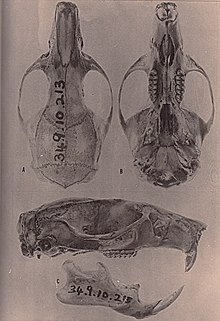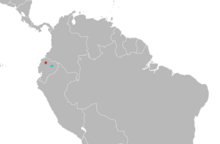Hammond's rice rat
| Hammond's rice rat | |
|---|---|

| |
| Skull and mandible[1] | |
| Scientific classification | |
| Domain: | Eukaryota |
| Kingdom: | Animalia |
| Phylum: | Chordata |
| Class: | Mammalia |
| Order: | Rodentia |
| Family: | Cricetidae |
| Subfamily: | Sigmodontinae |
| Genus: | Mindomys |
| Species: | M. hammondi
|
| Binomial name | |
| Mindomys hammondi (Thomas, 1913)
| |

| |
| Distribution of Mindomys: Mindo ( type locality) in red; Concepción (dubious second locality) in blue.[3]
| |
| Synonyms[Note 1] | |
| |
Mindomys hammondi, also known as Hammond's rice rat[2] or Hammond's oryzomys,[8] is an endangered species of rodent in the tribe Oryzomyini of family Cricetidae. Formerly considered to be related with Nectomys, Sigmodontomys, Megalomys, or Oryzomys, it is now placed in then genus Mindomys, but its relationships remain obscure; some evidence supports a placement near Oecomys or as a basal member of Oryzomyini.
Mindomys hammondi is known only from
The species is named after the collector who first found it, Gilbert Hammond. He supplied natural history specimens to Oldfield Thomas and others.[9]
Taxonomy
Discovery and classification in Nectomys
In 1913,
In his 1941 review The Families and Genera of Living Rodents, Sir John Ellerman retained N. hammondi as a species of Nectomys, but noted that the features of its teeth were atypical for the genus, as "the cusps appear to show no tendency to become suppressed."[11] Reviewing the genus Nectomys in 1944, Philip Hershkovitz listed N. hammondi among species of Nectomys incertae sedis (of uncertain position), and considered its placement in Nectomys as dubious. Characters he listed as conflicting with a Nectomys identity of the species included the short hindfoot with a long fifth toe, the weakly developed posterolateral palatal pits (perforations of the palate near the third molars), and the orientation of the zygomatic plate.[12]
Classification in Oryzomys
Hershkovitz published again on Nectomys in 1948 after examining additional material, including the
In his 1962 Ph.D. thesis, Clayton Ray considered O. hammondi to be most closely related to Megalomys, which includes giant rats from the Caribbean, and classified it as a member of the subgenus Megalomys of genus Oryzomys.[13] In 1970, Hershkovitz treated the species in another publication and noted that his name Macruroryzomys was a nomen nudum ("naked name") because he had not explicitly mentioned characters differentiating it from other taxa in his 1948 publication.[14] Nevertheless, he did not do anything to rectify the situation, and Macruroryzomys remains a nomen nudum.[15] Hershkovitz rejected any relationship between O. hammondi and Nectomys or O. aphrastus[16] and instead argued that O. hammondi was closely similar to Megalomys and may be close to the ancestor of Megalomys.[17] In 1982, Steadman and Ray mentioned the animal in passing under the name Macruroryzomys hammondi and reaffirmed its relationship to Megalomys.[18] In the 2005 third edition of Mammal Species of the World, Guy Musser and Michael Carleton listed O. hammondi as an Oryzomys of obscure affinities, but suggested that it may be related to Megalomys.[8]
Classification in Mindomys
In 2006, Marcelo Weksler published a large-scale
Traits of O. hammondi that supported the latter placement include: a relatively short palate that does not extend behind the
In Weksler's analysis, species placed in Oryzomys did not form a coherent (
Mindomys is now one of about 28 genera[26] in the tribe Oryzomyini, which includes well over a hundred species distributed mainly in South America, including nearby islands such as the Galápagos Islands and some of the Antilles. Oryzomyini is one of several tribes recognized within the subfamily Sigmodontinae, which encompasses hundreds of species found across South America and into southern North America. Sigmodontinae itself is the largest subfamily of the family Cricetidae, other members of which include voles, lemmings, hamsters, and deermice, all mainly from Eurasia and North America.[27]
Description
Mindomys hammondi is a large rice rat;
Skull
In the
The
In the mandible, the mental foramen, an opening in the mandible just before the first molar, opens to the outside, not upwards as in a few other oryzomyines.[41] The upper and lower masseteric ridges, which anchor some of the chewing muscles, join at a point below the first molar and do not extend forward beyond that point.[3] There is no capsular process of the lower incisor, a trait Mindomys shares with only a few other oryzomyines.[42]
Molars
The
Distribution and ecology
A rare species, Mindomys hammondi is known only from Ecuador.[45] Between 1913 and 1980, eight specimens were collected at Mindo,[46] a "tiny agricultural community"[15] at 1,264 m (4,147 ft) elevation in Pichincha Province, northwestern Ecuador. Another specimen is labeled as having been collected on July 27, 1929, by the Olalla family of professional collectors in Concepción, a locality in the Amazon basin lowlands of Napo Province, around 300 to 500 m (980 to 1,640 ft) above sea level. If this record is correct, Mindomys would be unique among small, non-flying mammals native to Ecuador in occurring at relatively low elevations on both sides of the Andes.[46] Furthermore, other collectors working in the same area in Napo have failed to find Mindomys, and the date the specimen was reportedly collected does not accord with the dates reported for the visit of the Olallas to Concepción, rendering its provenance dubious.[47] There are two other locations named "Concepción" in northwestern Ecuador, and Diego Tirira suggested in 2007 that the specimen may instead be from one of these. Another specimen is known from Chaco, Imbabura Province, at an altitude of 630 m (2,070 ft).[29]
Citing unpublished work by Tirira and Percequillo, the 2009 IUCN Red List reports that Mindomys is known from eleven specimens collected at four localities in northwestern Ecuador, and that its altitudinal range extends from 1,200 to 2,700 m (3,900 to 8,900 ft) above sea level, but does not give details.[2] The species occurs in moist, montane forest on the foothills of the western Andes.[48]
Almost nothing is known of the biology of Mindomys.
Conservation status
The IUCN Red List lists Mindomys hammondi as "endangered" in view of its small known distribution and a continuing decline in the extent and quality of its habitat. Up to 40% of its habitat may already have been destroyed, and the species was last recorded in 1980. It is not known to occur in any
Notes
- new combinations(the first use of a given combination of a genus and species name) are indicated by a colon between the name combination and the authority which first used the combination. No colon is used when the name is entirely new.
- ^ Measurements are listed by Hershkovitz[35] and Weksler.[36] Head and body length, as given by Weksler, is based on an unknown number of specimens in the BMNH. The other four measurements are given by Hershkovitz and are of the holotype and four other specimens in the BMNH (skull and hindfoot length) or of the holotype only (tail and ear length).
References
- ^ Ray, 1962, plate XV
- ^ a b c d e Tirira et al., 2008
- ^ a b c d e f Weksler et al., 2006, p. 17
- ^ Thomas, 1913, p. 570
- ^ a b c Hershkovitz, 1948, p. 56
- ^ Steadman and Ray, 1982, p. 4
- ^ a b c d e Weksler et al., 2006, p. 16
- ^ a b Musser and Carleton, 2005, p. 1149
- OCLC 270129903.
- ^ Thomas, 1913, p. 570; Musser and Carleton, 2005, pp. 1148–1149, 1177–1178
- ^ Ellerman, 1941, p. 362
- ^ Hershkovitz, 1944, p. 82
- ^ Ray, 1962
- ^ Hershkovitz, 1970, p. 791
- ^ a b c d Weksler et al., 2006, p. 18
- ^ Hershkovitz, 1970, p. 792
- ^ Hershkovitz, 1970, p. 794
- ^ Steadman and Ray, 1982, pp. 4, 18
- ^ Weksler, 2006, figs. 34–35, 37–38
- ^ Weksler, 2006, pp. 124, 34–36, 41–42, 48
- ^ Weksler, 2006, table 5
- ^ Weksler, 2006, p. 138
- ^ Weksler et al., 2006, p. 17; Percequillo et al., 2011, p. 389
- ^ Weksler, 2006, pp. 138, 30–32
- ^ Weksler, 2006, pp. 75, 77, fig. 42
- ^ a b Weksler et al., 2006, p. 1
- ^ Musser and Carleton, 2005
- ^ Weksler, 2006, fig. 44
- ^ a b c d e Tirira, 2007, p. 171
- ^ a b McCain et al., 2007, p. 129
- ^ Weksler et al., 2006, p. 19; Tirira, 2007, p. 170
- ^ a b c Tirira, 2007, p. 170
- ^ Weksler et al., 2006, p. 16; Weksler, 2006, pp. 23–24
- ^ Weksler, 2006, p. 17, table 5
- ^ Hershkovitz, 1970, table 2
- ^ Weksler, 2006, table 8
- ^ Weksler, 2006, pp. 27–28, table 5
- ^ Weksler, 2006, pp. 30–31
- ^ Weksler, 2006, pp. 32, 34, table 5
- ^ Weksler, 2006, p. 40
- ^ Weksler, 2006, p. 41, table 5
- ^ Weksler, 2006, pp. 41–42
- ^ Weksler, 2006, pp. 43–44
- ^ Weksler et al., 2006, pp. 17–18; McCain et al., 2007, p. 129
- ^ Weksler et al., 2006, p. 16; Tirira et al., 2008
- ^ a b Weksler et al., 2006, p. 16, footnote 5
- ^ Weksler et al., 2006, p. 16, footnote 5; McCain et al., 2007, p. 135
- ^ Tirira, 2007, p. 171; Tirira et al., 2008
- ^ Eisenberg and Redford, 1999, p. 395
Literature cited
- Eisenberg, J.F. and Redford, K.H. 1999. Mammals of the Neotropics. Volume 3, The central Neotropics: Ecuador, Peru, Bolivia, Brazil. ISBN 978-0-226-19542-1
- Ellerman, J.R. 1941. The families and genera of living rodents. Vol. 2. Family Muridae. London: British Museum of Natural History, 690 pp.
- Hershkovitz, P. 1944. "A systematic review of the Neotropical water rats of the genus Nectomys". Miscellaneous Publications of the Museum of Zoology, University of Michigan 58:1–88.
- Hershkovitz, P. 1948. "Mammals of northern Colombia. Preliminary report No. 3: Water rats (genus Nectomys), with supplemental notes on related forms". Proceedings of the United States National Museum 98:49–56.
- Hershkovitz, P. 1970. "Supplementary notes on Neotropical Oryzomys dimidiatus and Oryzomys hammondi (Cricetinae)" (subscription required). Journal of Mammalogy 51(4):789–794.
- McCain, C.M., Timm, R.M. and Weksler, M. 2007. "Redescription of the enigmatic long-tailed rat Sigmodontomys aphrastus (Cricetidae: Sigmodontinae) with comments on taxonomy and natural history" (subscription required). Proceedings of the Biological Society of Washington 120:117–136.
- OCLC 62265494.
- Percequillo, A.R., Weksler, M. and Costa, L.P. 2011. "A new genus and species of rodent from the Brazilian Atlantic Forest (Rodentia: Cricetidae: Sigmodontinae: Oryzomyini), with comments on oryzomyine biogeography" (subscription required). Zoological Journal of the Linnean Society 161(2):357–390.
- Ray, C.E. 1962. "The Oryzomyine Rodents of the Antillean Subregion". Doctor of Philosophy thesis, Harvard University, 211 pp.
- Steadman, D.W. and Ray, C.E. 1982. "The relationships of Megaoryzomys curioi, an extinct cricetine rodent (Muroidea: Muridae) from the Galápagos Islands, Ecuador". Smithsonian Contributions to Paleobiology 51:1–23.
- Thomas, O. 1913. "New mammals from South America". Annals and Magazine of Natural History (8)12:566–574.
- Tirira, D. 2007. "Guia de campo de los mamíferos del Ecuador". Quito: Ediciones Murciélago Blanco, publicación especial sobre los mamíferos del Ecuador 6, 576 pp. (in Spanish). ISBN 9978-44-651-6
- Roach, N.; Naylor, L. (2019). "Mindomys hammondi". IUCN Red List of Threatened Species. 2019: e.T15597A22330151. Retrieved 22 December 2019.
- Weksler, M. 2006. "Phylogenetic relationships of oryzomyine rodents (Muroidea: Sigmodontinae): separate and combined analyses of morphological and molecular data". Bulletin of the American Museum of Natural History 296:1–149.
- Weksler, M., Percequillo, A.R. and Voss, R.S. 2006. "Ten new genera of oryzomyine rodents (Cricetidae: Sigmodontinae)". American Museum Novitates 3537:1–29.

